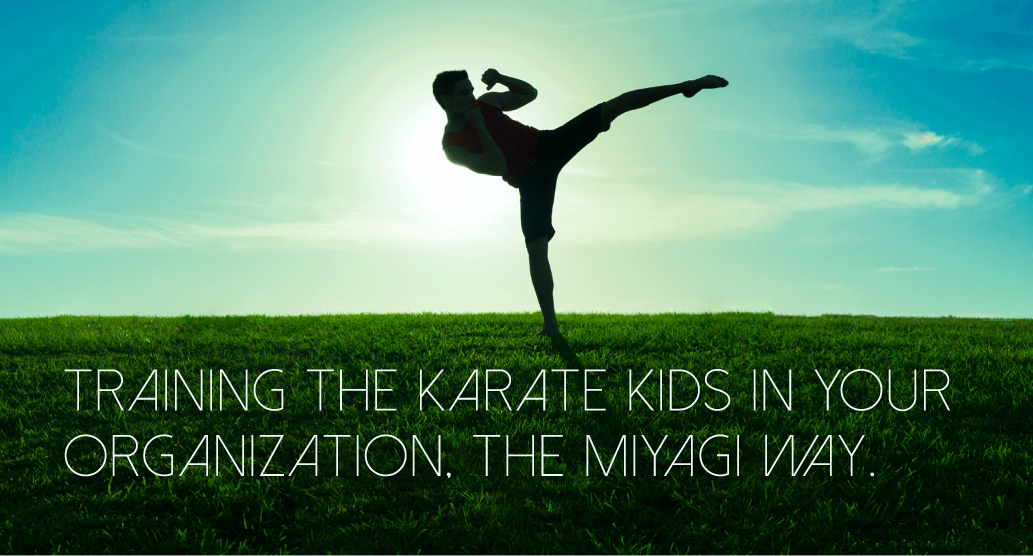
Training the Karate Kids in Your Organization. The Miyagi Way.
The Millennials are coming. Actually, they’ve already been here, and they are called adults. As we prepare to embrace the disruption and overhaul we anticipate to our learning ecosystems as Millennials permeate our workforce, let’s not forget about the fact that they still are adults, and that we know a lot about adult learning from years of practical experience and studies. Even Mark Zuckerberg is looking pretty grown up, these days. The Karate Kids in your organization now and in the future are all adults. Let’s learn how to best accommodate their learning, with advice from Mr. Miyagi.
Here are 4 things we know about all adult learners:
- Motivation – adults look for learning opportunities and experiences primarily because they have a use for the knowledge or competency being sought.
- Overlap – adults do best and learn more quickly when they are able to integrate new ideas with what they already know.
- Directness – straight-forward and direct knowledge, in a how-to format, is the preferred consumption modality. Don’t get too cute with your learning.
- Connection - self-directed learning does not mean siloed learning.
How to motivate an adult to learn
Learning is a motivated response to a need. Adults are motivated to look for learning opportunities and experiences primarily because they feel that they have a use for the knowledge or competency being sought. In this context, learning becomes the vehicle to get to the destination of skill acquisition. In the movie, Karate Kid, Daniel (Ralph Macchio) is motivated to learn Karate to exact some level of respect from his bully adversaries . . . and, in a nod to Hollywood’s romantic themes . . . to impress a girl.
With the variety of resources available to a modern learner, it has never been more important to make sure that you convey the value of each piece of learning offered to a learner. This means more than listing the objectives. What’s the WIIFM (what’s in it for me) for the learner? Some topics will sell themselves (hot tech topics like machine learning and AI), but how does a new project management course help an employee increase their potential for career advancement? Will taking a certain course make working with a coveted client easier? It’s time we as learning professionals start wearing our part-time marketing hats.
Overlap with the existing world of your learner
New knowledge is assimilated and leveraged with far greater speed when it is springboarded off of existing knowledge. In technology, this is also the basis for machine learning. Adults do best and learn more quickly when they are able to integrate new ideas with what they already know. Mr. Miyagi (Pat Morita) always started with the simple and built additional skills around it for his students.
When looking at the 5 Moments of Need (learning for the first time, learning more, applying what you've learned, problem solving when things go wrong, and learning when things change), it is clear that the last 4 moments are clearly hinged off of previous knowledge. Make sure you tie in relevant touchpoints when creating learning that will be accessed for the first time by someone, whether it be something related to the company, the intended demographic role of the learner, or even fundamental topics.
Don’t be afraid to be more direct and less cute
In the movie, much of the story is centered on the training techniques of the wise teacher and his student Daniel. In the movie, Daniel is asked to perform chores involving manual labor around his teacher’s house (waxing the car, pruning plants) – much to his frustration. What Daniel really wanted was to learn how to take down the bully in a competition Karate tournament to which he committed. Magically, over time, the student saw that all of the moves and discipline he perfected while performing these chores came in handy during the Karate tournament (wax on, wax off, block a kick, flip your opponent).
This was great for Hollywood. However, in the fast-paced and demanding world of today’s enterprise, your learners just may not have this level of dedication and patience. In fact, with e-learning, most of them are one-click away from you losing them. Even Mr. Miyagi realized that a quick and direct learning session was required when the rival sensei and his gang confronted him in the parking lot after the tournament, after all.
Straight-forward and direct knowledge, in a how-to format, is the preferred consumption modality. Don’t get too cute with your learning.
Fear not isolation for the self-directed learner
This is open for discussion (send me a comment below if you have thoughts on this topic!), but I think that as learning practitioners, we have two primary fears related to self-directed learning. One is that the animal that we know as the self-directed learner will gain knowledge and skills in a way that does not at all align with the organization’s needs for that person or role. The other fear, and potentially the more frightening one, is that the self-directed learning will somehow realize that they do not really need a learning department (gasp!).
Self-directed learning does not mean siloed learning. Studies show that self-directed projects involve an average of 10 other people as mentors, resources and supporters. Self-directed learners often rate short lectures and seminars highly – especially when it helps create a connection with an expert. Additionally, self-directed learners value learning professionals and organizations more when learning is readily accessible, properly curated and taxonomized, relevant and current.
Think about your learners as adults when they come into your organization, regardless of the sensational labels we place on them based on birth year, and you’ll see many common threads that will help you add value to your company and workforce as you create, curate and drive consumption of highly valuable content relevant to your workforce today and tomorrow. If you approach this holistically, you just may end up being viewed as a wise sage who offers needed value and a pathway to desired skills for the Karate Kids in your organization.
